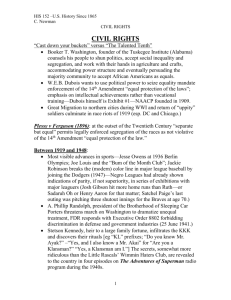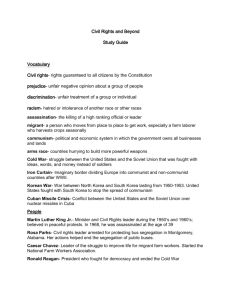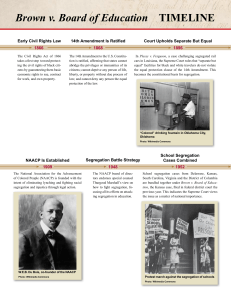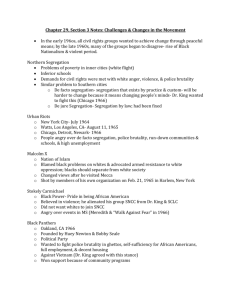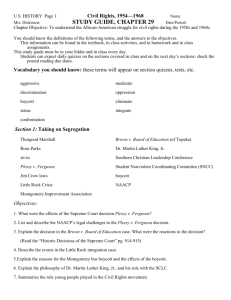Chapter 29 Civil Rights
advertisement
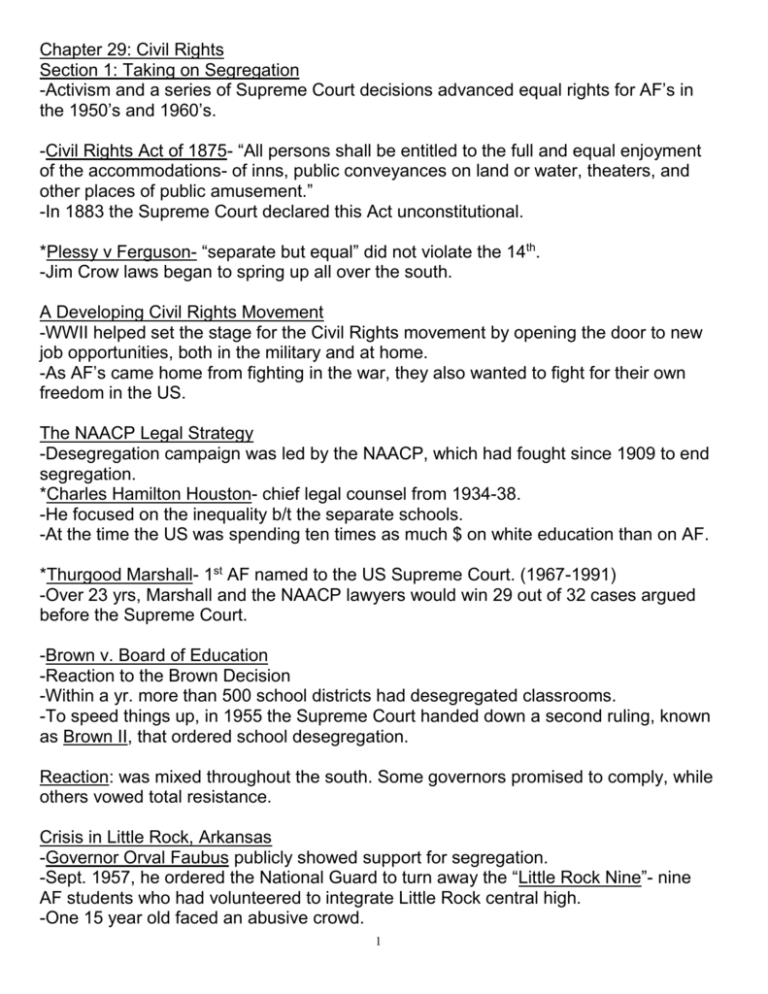
Chapter 29: Civil Rights Section 1: Taking on Segregation -Activism and a series of Supreme Court decisions advanced equal rights for AF’s in the 1950’s and 1960’s. -Civil Rights Act of 1875- “All persons shall be entitled to the full and equal enjoyment of the accommodations- of inns, public conveyances on land or water, theaters, and other places of public amusement.” -In 1883 the Supreme Court declared this Act unconstitutional. *Plessy v Ferguson- “separate but equal” did not violate the 14th. -Jim Crow laws began to spring up all over the south. A Developing Civil Rights Movement -WWII helped set the stage for the Civil Rights movement by opening the door to new job opportunities, both in the military and at home. -As AF’s came home from fighting in the war, they also wanted to fight for their own freedom in the US. The NAACP Legal Strategy -Desegregation campaign was led by the NAACP, which had fought since 1909 to end segregation. *Charles Hamilton Houston- chief legal counsel from 1934-38. -He focused on the inequality b/t the separate schools. -At the time the US was spending ten times as much $ on white education than on AF. *Thurgood Marshall- 1st AF named to the US Supreme Court. (1967-1991) -Over 23 yrs, Marshall and the NAACP lawyers would win 29 out of 32 cases argued before the Supreme Court. -Brown v. Board of Education -Reaction to the Brown Decision -Within a yr. more than 500 school districts had desegregated classrooms. -To speed things up, in 1955 the Supreme Court handed down a second ruling, known as Brown II, that ordered school desegregation. Reaction: was mixed throughout the south. Some governors promised to comply, while others vowed total resistance. Crisis in Little Rock, Arkansas -Governor Orval Faubus publicly showed support for segregation. -Sept. 1957, he ordered the National Guard to turn away the “Little Rock Nine”- nine AF students who had volunteered to integrate Little Rock central high. -One 15 year old faced an abusive crowd. 1 -This crisis forced Eisenhower to act. -Ike placed the AR National Guard under federal control and ordered a thousand paratroopers into the town. -At the end of the yr., the Governor shut down the high School rather than let integration continue. *1957 Civil Rights Act- shepherded by Senator LBJ of TX, the law gave the attorney general greater power over school desegregation. (It was the first Civil Rights law since Reconstruction.) The Montgomery Bus Boycott Boycotting Segregation -After the 1954 Brown decision, a letter was sent to the mayor of Montgomery, AL, asking that bus drivers no longer be allowed to force riders in the “colored” section to yield their seats to whites. The mayor refused. -1 Dec 1955 *Rosa Parks- a seamstress and an NAACP officer took a seat in the front row of the “colored: section of a Montgomery bus. -As the bus filled up, the driver ordered Parks & three other AF’s to get up so that a white man could sit down w/o having to sit next to any AF’s. -Parks refused to move and was arrested. -Leaders of the NAACP & of the AF community formed a boycott. -They elected MLK Jr. (26 year old) to lead the group. -AF’s filed a lawsuit & for 381 days refused to ride the buses in Montgomery. -Finally, in 1956, the Supreme Court outlawed bus segregation. MLK & the SCIC -King called his brand of nonviolent resistance “soul force”. -He based his ideas on the teachings of several people, such as Jesus, Henry David Thoreau, A. Philip Randolph, & Mohandas Gandhi. From the Grassroots Up *Southern Christian Leadership Conference (SCLC)- was founded by King & other civil rights leaders in 1957. -Its purpose was “to carry on nonviolent crusades against the evils of second-class citizenship.” -Ella Baker, who was the granddaughter of former slaves, led SCLC. -In 1960 she went on to help students at Shaw University, an AF university in Raleigh, NC, to organize a national protest group called the *Student Nonviolent Coordinating Committee (SNCC). *Sit-ins- in which AF protesters sat down at segregated lunch counters and refused to leave until they were served. 2 -On Feb 1960, AF’s at A & T University staged a sit-in at a whites-only lunch counter at a Woolworth’s store in Greensboro. Section 2: The Triumphs of a Crusade -Civil Rights activists broke through racial barriers and their activism prompted landmark legislation. *Freedom Riders- a group of civil rights activists who rode buses through the South in the early 1960’s to challenge segregation. -They hoped to provoke a violent reaction that would convince the Kennedy administration to enforce the law. -They were beaten, set on fire, verbally abused, & even killed for this, yet they kept riding. -JFK- would arrange to give the rider 400 US marshals to protect them as they finished their journey to Jackson, MS. -The attorney general and the Interstate Commerce Commission burned segregation in all interstate travel facilities. Integrating OLE Miss -Sep 1962- Air Force vet *James Meredith won a federal court case that allowed him to enroll in the all-white University. -When he arrived on campus, he faced Governor Ross Barnett, who refused to let him register. -JFK ordered federal Marshals to escort Meredith. Heading into Birmingham -Birmingham, a city known for its strict enforcement of total segregation in public life, also had a reputation for racial violence, including 18 bombings from 1957-1963. -MLK & SNCC were called in to help desegregate the city. -After days of demonstration, king & a small band of marchers were finally arrested. -After posting bond, King marched w/more than a thousand AF children. -Police commissioner Eugene “Bull” Connor’s men arrested 959 of them with a helmeted police force. -Police swept them off their feet with high pressure fire-hoes, sent attack dogs on them, and clubbed those who fell. -TV cameras captured all of it, allowing millions of viewers to see the police brutality and to hear the screaming children. -Continued protests, an economic boycott, and negative media coverage finally convinced Birmingham officials to end segregation. -It inspired AF’s across the nation & convinced JFK that only a new Civil Rights Act could end racial violence & satisfy the demands of AF’s & many whites for racial justice. 3 -June 1963- JFK sent in federal troops to force Governor George Wallace to honor a court order desegregating The University of Alabama. -Medgar Evers- an NAACP field Secretary & WWII veteran was murdered. The white man who was tried for his murder was released after 2 trials resulted hung juries. -AF’s were furious & demanded, “Freedom now!” Marching to Washington -JFK sent Congress a Civil Rights Bill. -To persuade Congress to pass the bill, two veteran organizers- labor leader A. Philip Randolph & Bayard Rustin of the SCLC- summoned a march on Washington DC. -More than 250,000 people- including 75,000 whites marched. -This is where Dr. MLK gave his famous “I have a Dream” speech. -Two weeks later the Birmingham Church Bombing killed four young girls. -Two months after that JFK was assassinated. -His successor, President Lyndon B. Johnson, pledged to carry on JFK’s work. -On July 2, 1964, LBJ signed the *Civil Rights Act of 1964- which prohibited discriminated b/c of race, religion, national origin, & gender. Fighting for Voting Rights -In 1964, Core & SNCC workers in the South began registering as many AF’s as they could to vote. -Focused in Mississippi, the project became known as *Freedom Summer. -Thousands of college students were recruited to help, most were white & about onethird were female. A New Political Party -AF’s needed a voice in the political arena if a sweeping change was going to occur. -In order to gain a seat in the Mississippi all-white democratic party, SNCC organized the *Mississippi Freedom Democratic Party (MFDP)- which was led by *Fannie Lou Hamer. -At the 1964 democratic national convention, a televised speech shocked the convention & viewers nationwide. -She described how she was jailed for registering to vote in 1962 & how police forced other prisoners to beat her. (p. 921) -As a result, massive support of seating the MFDP delegates poured in. -LBJ feared losing the southern white vote if the democrats sided with the MFDP, so he pursued a compromise. The democrats would give 2 of the Mississippi’s 68 seats to the MFDP, with a promise to ban discrimination at the 1968 convention. -Hamer & supporters were mad that they only received 2 seats, & felt like their leaders betrayed them. -In 1965, the SCLC held a mayor voting rights campaign in Selma, AL, where SNCC had been working for 2 years to help get voters registered. 4 -By the end of 1965, more than 2,000 AF’s were arrested and one demonstrator was shot and killed. -MLK responded with a protest march from Selma to Montgomery, the state capital. -March 7, 1965- about 600 protesters set out. -That night, mayhem broke out. -As TV cameras captured the scene the nation watched in horror. -Police swung whips and clubs and clouds of tear gas swirled around fallen marches. Result: Demonstrators poured out to Selma by the hundreds and LBJ asked Congress for swift passage of the *Voting Rights Act of 1965- a law that made it easier for AF’s to register to vote by eliminating the literacy test & authorizing federal examiners to enroll voters who had been denied registration at the local level. Section 3: Challenges & Changes in the Movement -Disagreements among civil rights groups & the rise of Black Nationalism created a violent period in the fight for civil rights. African Americans Seek Greater Equality Northern Segregation *De facto segregation- segregation that exists by practice & customs. *De jure segregation- segregation by law. -De facto segregation intensified after AF’s migrated to northern cities during & after WWII. -This began a “white flight”, in which great numbers of whites moved out of the cities to the nearby suburbs. Urban Violence Erupts -In the mid-1960s clashes between white authority & black civilians spread like wildfire. New Leader Voice Discontent *Malcolm X- born Malcolm Little, he went to jail at age 20 for burglary. -While in prison, he studied the teachings of Elijah Muhammad, the head of the *Nation of Islam- or the black Muslims. -Malcolm changed his name to Malcolm X. (Dropping what he called his “slave name”) -Viewed that whites were the cause of the black condition & that blacks should separate from white society. -Believed in violence as a means to fight racism. -Black Power- tensions building b/t SNCC & the other civil rights groups finally erupted in Mississippi. -225- mile “walk against fear”. *Stokely Carmichael- took up the march after James Meredith was shot & too injured to continue to walk. 5 *Black Power-a “call for black people to begin to define their own goals & lead to their own origin.” *Black Panthers- a political party to fight police brutality in the ghetto. They advocated self-sufficiency for AF communities, as well as full employment & decent housing. -Dressed in black leather jackets, black berets, & sunglasses, they preached selfdefense & sold copies of the writings of Mao Zedong, the leader of the Chinese Communism revolution. -4 April 1968- MLK was shot by James Earl Ray. -MLK’s death lead to the worst urban rioting in US history. A Jordanian immigrant who was angry over Kennedy’s support of Israel assassinated Robert Kennedy in June 1968. *Kenner Commission- LBJ had appointed the commission to study the causes of urban violence. The panel named one main cause, “white racism”. -The report called for the nation to create new jobs, construct new housing, & end de facto segregation in order to wipe out the destructive ghetto environment. -LBJ administration ignored many of the recommendations. *Civil Rights Acts of 1968- ended discrimination in housing. *Reverend Jesse Jackson- sought the democratic nomination for president in 1984 & 1988. *Affirmative Action- in the 1960’s to equalize education & job opportunities. -In the late 1970’s, some people began to criticize affirmative action programs & label it as “reverse discrimination”. 6



